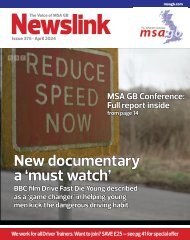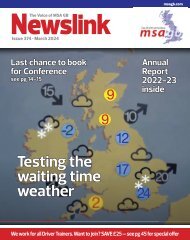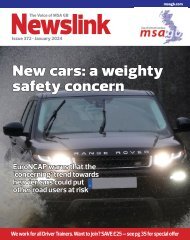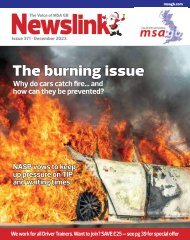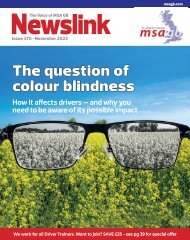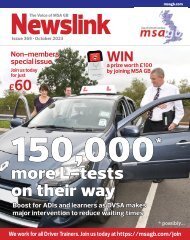Newslink April marketing special
Motor Schools Association of Great Britain - driving instructors - marketing and new members special. Road safety, driver training and testing
Motor Schools Association of Great Britain - driving instructors - marketing and new members special. Road safety, driver training and testing
You also want an ePaper? Increase the reach of your titles
YUMPU automatically turns print PDFs into web optimized ePapers that Google loves.
Conference 2024 Telford: Full report<br />
Session 5: John Lepine MBE<br />
European matters, and<br />
road safety’s future<br />
MSA GB’s former general manager John<br />
Lepine MBE gave delegates a look at some<br />
of initiatives emerging from Europe in the<br />
driver testing and training profession, from<br />
his vantage point of working with the<br />
European Driving Schools Association,<br />
EFA.<br />
He started by comparing the learningto-drive<br />
journeys pupils take in Ireland,<br />
France, Belgium and Holland, finding many<br />
similarities with Britain’s - but many<br />
glaring differences too.<br />
In Ireland, a theory test pass is needed<br />
before practical tuition can start, with<br />
lessons opening with 12 hours of<br />
mandatory tuition. The test itself can be as<br />
long as 100 minutes, and costs €85<br />
In France, two systems exist. The<br />
Apprentissage Anticipé de la Conduite<br />
(AAC) can begin at 15 if certain criteria are<br />
met. First the pupil must sign up with a<br />
registered driving school for an “evaluation<br />
of knowledge”. If successful, they then<br />
follow a minimum of 20 hours driving<br />
practice with a school before taking a<br />
general theory test. If successful, a<br />
certificate is issued that is valid for five<br />
years to drive accompanied by an adult,<br />
with three obligatory teaching follow-ups<br />
by the driving school.<br />
This is an expensive course, requires a<br />
lot of parental involvement and is regarded<br />
as a very middle class programme, but is<br />
effective, with a 70 per cent L-test pass<br />
rate.<br />
For those reluctant to go down this path,<br />
a cheaper option has a theory test followed<br />
by a practical exam from the age of 18.<br />
Interestingly the theory test pass entitles<br />
the holder to five goes at the L-test, rather<br />
than the two-year deadline in Great Britain.<br />
The Netherlands’ system is perhaps the<br />
closest to ours. Some differences remain<br />
- lessons can be only with an ADI, refresher<br />
training is required for ADIs, but the<br />
outcomes are similar, with around 42 hours<br />
of training taken on average for a pass.<br />
Belgium’s system is befitting a nation<br />
with such a complicated linguistic, political<br />
and civic structure: chaotic. There are eight<br />
paths to a licence, depending on which part<br />
of nation you live in.<br />
John provided a flowchart which<br />
highlighted the old adage that if Belgium<br />
didn’t exist, no one would be daft enough<br />
to invent it.<br />
Simusafe/FitDrive<br />
Two projects EFA had been involved in<br />
were Simusafe and Fit Drive. The first<br />
looked at the benefits of using simulators<br />
for teaching driving. A research programme<br />
had found benefits, particularly in areas<br />
that were difficult to teach in real life such<br />
as bad weather driving, night-time driving<br />
and how to safely use advanced driver<br />
assistance systems.<br />
FitDrive was focused on looking at a<br />
driver’s medical profile and trying to<br />
protect everyone from unexpected<br />
medical emergencies that were a danger to<br />
other road users. It monitors a driver’s<br />
health over a long period and creates an<br />
identikit of your health, with warnings if<br />
changes in health occur.<br />
The question of dual controls<br />
A third project of interest had links with<br />
conference supporter and exhibitor<br />
He-Man, the manufacture of dual controls.<br />
EFA has asked, what happens to dual<br />
controls when they are no longer needed?<br />
The research considered the fate of old<br />
duals across Europe, with some interesting<br />
differences in what happens to them.<br />
Some countries insist they are disposed<br />
of and cannot be re-used, but others,<br />
including Great Britain, have no regulations<br />
covering their subsequent use. He-Man’s<br />
concern is that second hand duals could<br />
end up being re-used, with incorrect fitting<br />
and be a danger to the public.<br />
It was noted that all countries require<br />
dual controls, though in some they have a<br />
third pedal to act as the accelerator.<br />
In France a buzzer fitted to the duals tells<br />
the learner when the ADI has intervened<br />
on their behalf.<br />
First aid lessons<br />
Many nations in Europe have a First Aid<br />
component in their driver training<br />
curriculum. As part of this, EFA had led on<br />
the Basic Life Support Project with a<br />
campaign called ‘Learn To Drive. Learn<br />
CPR’, produced in collaboration with the<br />
European Resuscitation Council (ERC). This<br />
encouraged a greater awareness of how<br />
CPR can save a life in the event of a cardiac<br />
arrest, and combined learning it with<br />
learning to drive.<br />
EFA had commissioned a catchy upbeat<br />
dance track with lyrics in English telling<br />
young people how to administer CPR - and<br />
was thrilled to win the Best Road Safety<br />
Project Award at the CIECA 2024<br />
Conference in Dubai.<br />
Conference enjoyed watching the video,<br />
which you can see for yourself by clicking<br />
HERE.<br />
26 NEWSLINK n APRIL 2024






